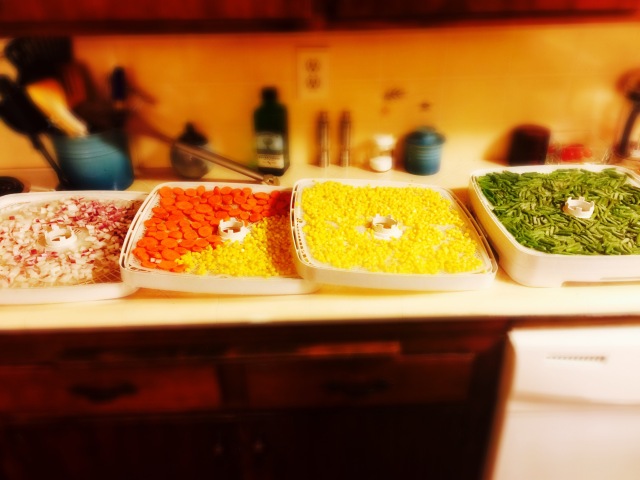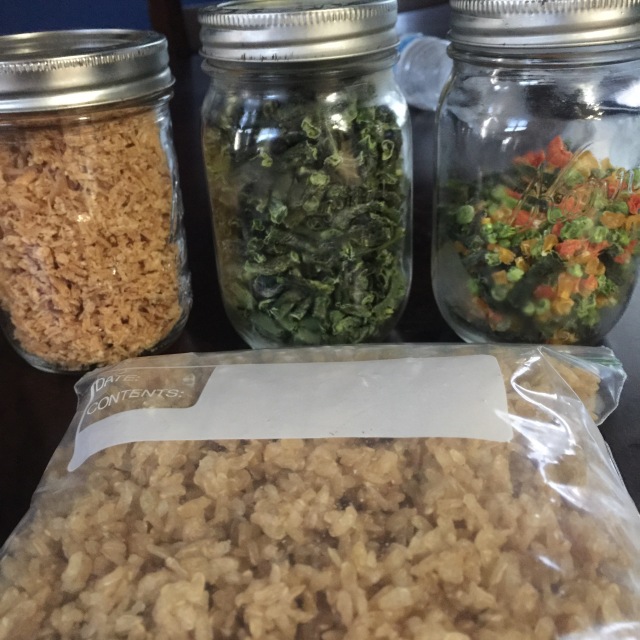You may have heard that “food tastes better on the trail”. It’s true, and there’s a scientific explanation: Our bodies go through a physiological response to being in nature. Changes in blood pressure, pulse rate, heart rate, salivary cortisol and hemoglobin in the brain’s prefrontal cortex stimulates the parasympathetic branch of our nervous system. The parasympathetic branch is sometimes called the “rest and digest” branch, and when it kicks in, food tastes A-MAZING.

But food is also fuel, so we should pay close attention to what we stick in our mouths while backpacking to give our bodies their best chance at strength, recovery and adaptability so we’ll feel more comfortable and have less aches and pains (training helps, too).
There are lots of companies that prepare and sell dehydrated food for backpackers. Some are organic. Some are labeled as “gourmet”. Some are all-natural. And many are pure, ultra-processed junk. Aside from the quality, these pre-packaged foods are designed using a one-size-fits-all approach. Almost every offering is packaged for what the company defines as “food for two people”.
But some people are bigger or smaller than others and metabolism is different from one person to another. My caloric needs on the trail are different than my husband’s or my 10-year-old son’s. These foods also don’t take into account how many miles you accomplished in one day, or how long your trip is.
When I backpack solo, or in a group of people I’m not sharing food with, I can eat about 1.5 servings of pre-packaged food before I feel like vomiting. And since I have no Tupperware nor a fridge, I can’t keep the leftovers. If no one else wants them, then what? I’ve made myself sick trying to force the extras down. I’ve had to dig holes to bury what’s remaining in the bag (you boil water and pour it directly into the bag). What a waste of food – and money!
So I stopped buying backpacking food and set out to make my own. I found it really wasn’t difficult and in the long run is way cheaper than buying the pre-packaged stuff. Plus, it’s much healthier. I once dehydrated enough food for three people for an entire thru-hike of the John Muir Trail (22 days of food for three).

When you dehydrate foods, it takes a long time, so you can just set it and forget it! I dehydrate one batch while I’m at work, then a different batch while I sleep. And so on until I’m done.
First step: buy a dehydrator. Any dehydrator will do, but if you can afford to be choosy, choose the biggest one you can get with a temperature selector. Many low-end models have only one temperature setting. Also, I highly recommend you buy one in the shape of a square. Many dehydrators are circles, and I just don’t get that. There’s so much more room when the trays are square! I have the Nesco FD-80A and love it.
Next, make sure you buy the recommended tray inserts, both the mesh kind and the solid, plastic, non-stick trays. If you read articles about using parchment paper instead of non-stick trays, ignore them! It’s WAY easier to use the trays and, depending on what you are dehydrating, parchment WILL NOT WORK.
Now you need ingredients. To save a ton of time and money, buy chopped, frozen veggies – I buy organic.

I also dehydrate grass fed ground beef and bison, as well as organic chicken. Two important tips here: 1) All ground red meat must be pre-cooked with breadcrumbs before dehydrating AND 2) All chicken must come from a can.
Pre-cooking ground meat allows you to break it into tiny pieces. Otherwise, you would be trying to dehydrate chunks. The bread crumbs don’t alter the taste and are included to absorb and rehydrate the meat when you add water on the trail. Regular chicken just doesn’t dehydrate well. Canned chicken is pressure-cooked in the can, and for reasons way above my pay grade, it dehydrates perfectly. When you re-hydrate and cook it on the trail, you won’t notice it was ever in a can!
I also dehydrate herbs and leafy veggies like kale and Swiss chard. I love adding dehydrated onions to my recipes, but make sure you dehydrate those when you aren’t at home because your whole house will stink (I actually have some dehydrating in my garage as I write this!). Many people make their own beef jerky, but I haven’t done that yet. Not enough time!
You can dehydrate pasta sauce, salsa, cooked/blended beans and even enchilada sauce. When dehydrated, these can be broken up and added to recipes. Try dehydrating mashed potatoes instead of buying the store-bought, processed crap. My sister once made me Mexican mole sauce and that dehydrated well, too. Watch the fat content of your meats and sauces – oils and fats don’t dehydrate easily and can spoil.
For pasta and rice dishes, cook them like normal and THEN dehydrate them. Dehydrated brown rice cooks up on the trail in just a few minutes. If you brought un-cooked brown rice on the trail, it would take forever. Try other grains like faro, barley and wild rice, too. Again, always cook first, then dehydrate. (Try cooking in chicken or beef broth for added flavor when re-cooking on the trail.)
Look online or buy a book for recipes and inspiration. I buy powdered whole milk (the extra fat is good and it tastes better), powdered coconut milk, curry powders, spices and other flavorings to make my meals. On Amazon, you can buy bulk powdered cheese sauce (like the kind in a box of mac-and-cheese). When combined with powdered milk, and perhaps even some powdered butter, you can make an amazing beefy mac-and-cheese on the trail! My favorite meal ever is mango chicken curry with veggies and rice. It’s amazing! The enchilada sauce one-pot meals are great, too.

If you like to eat packaged ramen on the trail, give it some actual nutritional value by adding some dehydrated meat and veggies. You can also buy powdered eggs (this link takes you to the only tasty brand), add dehydrated veggies and/or meat, sprinkle some powdered cheese on top and have an amazing scramble in the back country (this requires a stove that allows for a simmer and a small pan as a pot doesn’t have enough surface area)!
Packaging the food is a bit of an art and you should follow your recipe’s instructions for how-to’s. For small things, like a pine nuts or flavorings you want to add at the end of the cooking process, cut snack-sized baggies in half and tape up the cut end. Write cooking instructions on a piece of paper towel or napkin and slip that inside your main bag. Now you have instructions and a napkin! Remember: you’ll need to pack out your trash so bring a large bag for that purpose or use the bags your food was packed in.
One potential downside to cooking your own food is that you’ll need to cook it in your pot, thereby requiring you to clean the pot after each meal. You may meet backpackers who insist you can pour boiling water directly into your zip lock bag of dehydrated ingredients. Please don’t listen to these people! Time and time again, scientists have proven beyond a shred of a doubt that this practice is dangerous and unhealthy. You can actually buy special bags designed for boiling food, but they are rather thick and bulky, which make them tough to pack into a backpack or bear canister.
I store my ingredients in mason jars or freezer-type plastic bags in the freezer until I’m ready to make meals out of them. Many people buy a vacuum sealer and package their trail food that way. I haven’t made that investment yet and find that plastic baggies work just fine. I use freezer bags because they are thicker and less likely to puncture from some sharp piece of dehydrated food.

When I’m on the trail, my meals are the envy of everyone I meet! They are nutritious, delicious and satisfying and help me perform at my best.
“A crude meal, no doubt, but the best of all sauces is hunger.” – Edward Abbey

